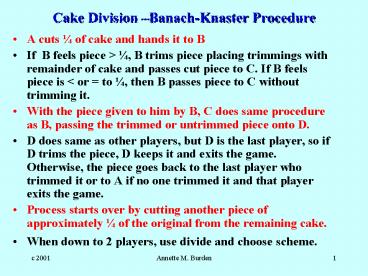Cake Division BanachKnaster Procedure
1 / 8
Title:
Cake Division BanachKnaster Procedure
Description:
However, if C trimmed a piece in step 3, he must select that piece if it is ... Now trimmings must be divided using same procedure (apply the trimming procedure ... –
Number of Views:87
Avg rating:3.0/5.0
Title: Cake Division BanachKnaster Procedure
1
Cake Division Banach-Knaster Procedure
- A cuts ¼ of cake and hands it to B
- If B feels piece gt ¼, B trims piece placing
trimmings with remainder of cake and passes cut
piece to C. If B feels piece is lt or to ¼, then
B passes piece to C without trimming it. - With the piece given to him by B, C does same
procedure as B, passing the trimmed or untrimmed
piece onto D. - D does same as other players, but D is the last
player, so if D trims the piece, D keeps it and
exits the game. Otherwise, the piece goes back to
the last player who trimmed it or to A if no one
trimmed it and that player exits the game. - Process starts over by cutting another piece of
approximately ¼ of the original from the
remaining cake. - When down to 2 players, use divide and choose
scheme.
2
(No Transcript)
3
Cake Division Selfridge-Conway Procedure
- Independently discovered by Selfridge and Conway
circa 1960. - Player A divides cake into what he considers to
be 3 pieces. - A passes the pieces to player B who trims at most
1 of the 3 pieces to create a tie for the largest
piece. B sets aside the trimmings and passes the
3 pieces to player C. - Player C chooses the piece he considers tied for
largest.
4
Cake Division Selfridge-Conway Procedure
- Player B must now choose a piece from the
remaining 2 pieces that he considers tied for
largest. However, if B trimmed a piece in step 3,
he must select that piece if it is still
available. - Player A gets the remaining piece.
- Now trimmings must be divided as follows
- Player B cuts the trimmings into 3 pieces he
considers to be the same size. - Players choose which of the three pieces they
want in the following order Player C, A, and
finally B.
5
(No Transcript)
6
Cake Division 1992 Envy-Free Procedure
- Player A divides cake into what he considers to
be 5 pieces. - A passes the pieces to player B who trims at most
2 of the 5 pieces to create a 3 way tie for the
largest piece. B sets aside the trimmings and
passes the 5 pieces to player C. - Player C trims at most 1 of the 5 pieces to
create at least a 2 way tie for the largest
piece. C places the trimmings with the other
trimmings and passes the 5 pieces to player D. - Player D chooses the piece he considers tied for
largest.
7
Cake Division 1992 Envy-Free Procedure
- Player C must now choose a piece from the
remaining 4 pieces that he considers tied for
largest. However, if C trimmed a piece in step
3, he must select that piece if it is still
available. - Player B must now choose a piece from the
remaining 3 pieces that he considers tied for
largest. However, if B trimmed a piece in step
2, he must select that piece if it is still
available. - Player A now selects from the remaining 2 pieces.
- Now trimmings must be divided using same
procedure (apply the trimming procedure an
infinite scheme) in a finite manner, i.e., keep
trimming until trimmings are so small no one
cares.
8
Credits
- COMAP, For All Practical Purposes, 5th ed































